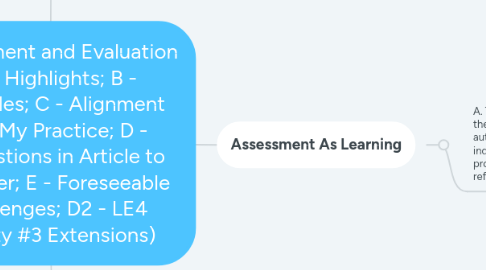
1. Assessment For Learning
1.1. A. Teachers provide students with descriptive feedback and coaching for improvement.
1.1.1. B. - co-construct goals and display; use clear language that involves students; posing questions that help students to think explicitly; provide precise information; ongoing procedure from onset; small and large group discussions to articulate thoughts and further develop thinking; analyzing and refining feedback
1.1.1.1. C. - co-constructing goals; conferencing with feedback; provide precise information; next steps in student friendly language; small and large group discussions to articulate thoughts and further develop thinking
1.1.1.1.1. D. - posing questions that help student to think explicitly; ongoing procedure from onset; analyzing and refining feedback; journaled questions for future discussions. D2. - to improve communication abilities and levels with all students; clear relaying of Achievement Chart to students and parents at beginning of year, displayed and referenced to in class, with highlighted criteria as per task;
2. Assessment Of Learning
2.1. A. - Summative assessments
2.1.1. B. - individual and group portfolios; performance;, journals; observations; questions; rubrics; checklists; anecdotal comments; audio and video demonstrations; compositions; worksheets; self-assessments; reflective writing
2.1.1.1. C. - performances, observations, questions, rubrics, anecdotal comments, audio and videio demonstrations; compositions; worksheets; reflective writing
2.1.1.1.1. D. - individual and group portfolios; journals including questions for future discussions; checklists; self-assessments; D2. - applications by students through guided improvisation and use of technology
3. Assessment As Learning
3.1. A. Teachers help students to develop their capacity to be independent, autonomous learners who are able to set individual goals, monitor their own progress, determine next steps, and reflect on their thinking and learning.
3.1.1. B. - how to achieve co-constructed goals; teacher models success criteria and descriptive feedback; opportunities for peer and self-assessments; teacher feedback of student feedback, revising both if necessary; modelling, setting , and re-setting of goals; teach students the language and skills of assessment to enable self and peer assessments
3.1.1.1. C. - how to achieve co-constructed goals; teacher models success criteria and descriptive feedback; opportunities for peer and self assessments; modelling, setting , and re-setting of goals
3.1.1.1.1. D. - teacher feedback of student feedback, revising both if necessary; journaled questions for future discussions; teach students the language and skills of assessment to enable self and peer assessments; D2. - to reach all students when promoting their self-assessment and goal setting abilities; further develop my abilities to assess Thinking criteria (from Achievement Chart) through observations of students on task
